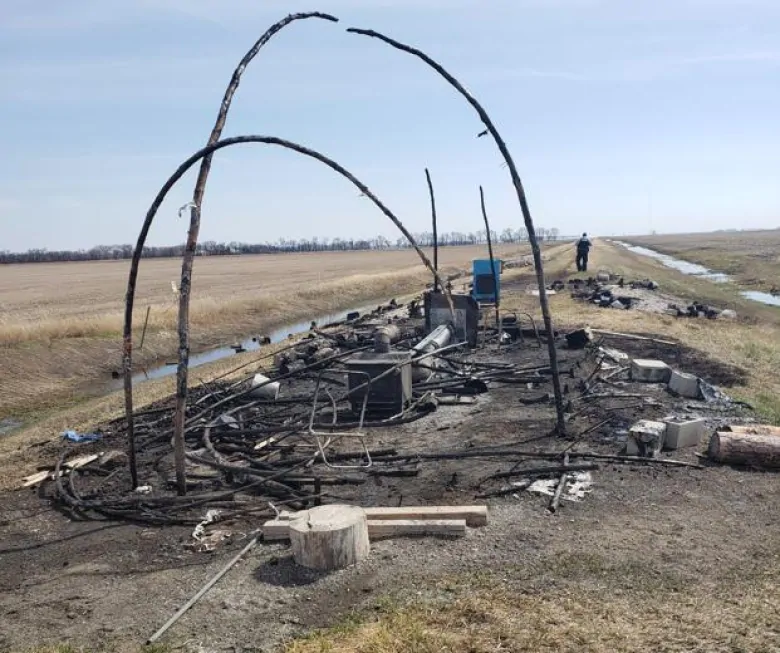RCMP investigating after fire destroys wigwam at Manitoba anti-pipeline camp

A torched traditional house and belongings at an anti-pipeline camp located near farmers fields in southern Manitoba is being investigated as arson, according to RCMP.
Some camp supporters and observers on social media are calling on police to investigate it as a hate crime.
“It felt like my whole world was gone,” said Geraldine McManus, a Dakota two-spirit person who has spent a lot of time organizing the Spirit of the Buffalo camp in the traditional territory.
“That camp means the world to me. That’s where I sit and speak with ancestors. That’s where we sit and pray. People don’t understand. It’s like someone coming and going and burning down a big church.”
A fire broke out Saturday at approximately 11 p.m. at the site near Highway 30 and the Gretna port of entry from North Dakota into Manitoba, RCMP spokesperson Paul Manaigre said in an email.
It was not called in to 911, he said.
A volunteer firefighter who lives nearby the area saw the fire Saturday night and reported it to his crew, who in turn attended and put it out. Carman RCMP received the report Sunday morning.
A wigwam and several wood piles were destroyed, police said.
‘Whole thing is gone’
Camp leader McManus said more than $1,700 in firewood for a sweat lodge was ruined by blaze earlier on Saturday.
“They burned that first, so I came to town to kind of regroup my mind,” McManus said, adding that “they left a hell of a big mess when they set that fire.”
McManus had planned to return to camp to clean it up on Sunday. That was until friends delivered the message: “The whole thing is gone now. They burned the entirety of everything down,” McManus said.
McManus said the Spirit of the Buffalo is located on Crown land has been claimed by the camp in an international area along the Canada-U.S. border between Gretna and Emerson, Man.
It has been almost two years since people opposing pipeline development through the region began demonstrating at the camp atop Enbridge’s Line 3 project.
A community of supporters who visited the demonstration site helped build the permanent structure over the pipeline so McManus could stay there throughout the winter “to just pray and ask that those lines don’t get put in, that it doesn’t hurt the animals or the plants or the water or our people,” McManus said.
Some workers and farmers in the area have attempted to intimidate demonstrators at the site, according to McManus, who says the site is not a place of protest.
The group, which is receiving support from the Manitoba Energy Justice Coalition, refuses to leave the area, despite ongoing threats against pipeline opponents and their proximity to a nearby shooting range.
“It’s a prayer camp. It’s not an action camp. I’m not trying to, you know, burn peoples’ properties down. I’m out there praying on that line, that it doesn’t hurt everything in its path.”

“When we pray on things hard enough, we can make things happen,” McManus said.
“And that’s what I’ve been doing out there, praying and making things happen. And the ancestors keep speaking to me out there and showing me things to do. So it wasn’t like I was sitting out there alone. I was out there with the ancestors.”
Pipeline company responds
The crude oil infrastructure is designed with potential for a forest or surface fire, and is at a “more than a sufficient depth to ensure the safety of the pipeline, people and environment,” the company said in an email.
According to Enbridge, the pipeline infrastructure in the area is located at least four metres below the roadbed.
“In the event our pipeline infrastructure is threatened, we would activate our emergency response protocol in close cooperation with local first responders,” reads the statement.
Enbridge officials have said the pipeline, which was built in the 1960s, is deteriorating and needs to be replaced.
Current capacity is 390,000 barrels per day, but the new 36-inch pipeline will restore it to its former capacity of 760,000 barrels per day, the company said in July 2018. The original 34-inch pipeline will be deactivated and left in place, which Enbridge says causes less damage than removing it.
Enbridge said Monday it is cooperating with the police investigation.





